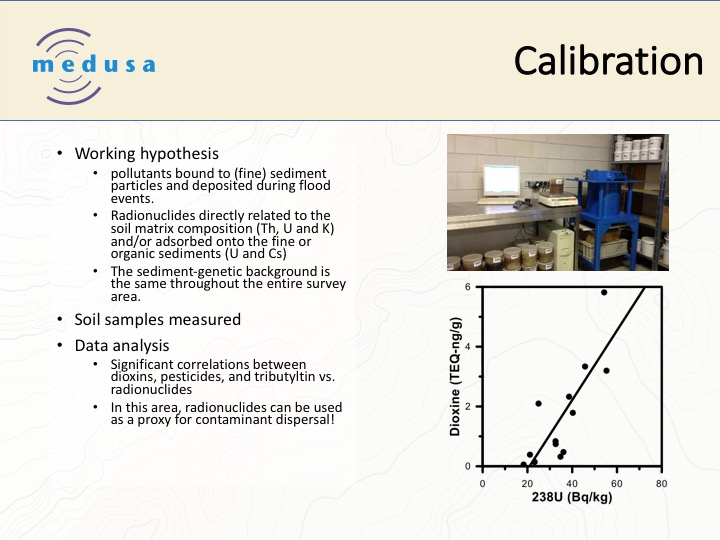Pollution mapping of PCDD/F
The Spittelwasser project
The investigation results shown have been obtained from a field study at the Spittelwasser creek and its floodplain in Saxony-Anhalt, Germany, which is a part of the Elbe river basin. It is highly contamined through waste water formerly discharged from the near-by Bitterfeld-Wolfen industrial mega site over many decades. In the Spittelwasser creek and the subsequent Mulde and Elbe rivers polychlorinated dibenzodioxins and furans (PCDD/F) play a prominent role, impairing sediment and surface water quality still today. Due to their specific affinity to solid particle surfaces, transport and fate of the PCDD/F are primarily a sediment issue involving riverine sediment deposits as well as the extended flood plain areas. Accordingly and due to the historical time frame of industrial source processes today’s contaminant distribution shows a complex spatial pattern. The objective of the study was to locate and quantify the PCDD/F in the floodplain soils and to assess their relevance compared to the PCDD/F load in the riverine system.
Risk assement
Identifying highly contaminated areas within the floodplains and the quantification the respective contaminant inventory is relevant for both the assessment of potential direct risks and for the assessment of recontamination mechanism and pathways to the relevant surface water bodies. However, conventional investigation strategies (sampling and lab analyses) are usually not practical when aiming to detect small scale variations or contamination hotspots. Therefore, an alternative innovative investigation technique was applied in the Spittelwasser floodplain. This indirect technique uses the Medusa MS-4000 field gamma spectrometer (Fig. 1) developed for indirectly determining texture, grain size and chemical composition of the top layer of soils or sediments. Following pre-defined grid lines in the field the quad-mounted gamma spectrometer measures the natural element-specific gamma radiation of the soil substrate originating from isotopes of potassium (40K), uranium (238U) and thorium (232Th) along with the very low concentrations of caesium (137Cs), from man-made fall-out since the early 1960ies. Previous studies have shown that various minerals or types of soil can be distinguished by their different isotopic compositions, their so-called ́radiometric fingerprint ́. In many cases, significant relationships were also found between one or more of the radionuclides (the proxy) and one of the textural or chemical properties of the sample. This relation has been used successfully to translate maps of the measured radionuclides into maps of sediment/soil texture and/or pollution levels.
The PCDD/F loads in the river course were obtained for several strategic points. Sediment traps were used to collect suspended matter that was analyzed for the PCDD/F concentration on a monthly scale. Discharge rates were measured by weekly campaigns and continuous water level metering at gauges installed. TSS concentrations were measured on a weekly scale using cumulative samples gathered by automatic samplers.
Mapping of PCDD/F in floodplain soils
In this study, we successfully applied the gamma-spectrometric method to PCDD/F and other organic compounds in floodplain soils, for the first time. On the one hand it was possible to identify areas of relatively high PCDD/F-concentration and other areas which are largely uncontaminated. Furthermore the PCDD/F inventory for five sub- areas was quantified. The inventories were correlated with the PCDD/F loads of the subsequent surface water bodies during normal and flood discharge to assess the recontamination potential from the flood plain areas investigated. The results documented the dominant impact of flood events in the overall transport regime and were used to identify the input pattern from the floodplain.






more information:
https://enveurope.springeropen.com/articles/10.1186/s12302-016-0075-8
